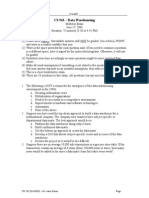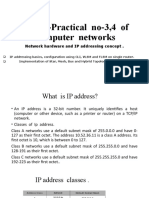Network and Information Security Laboratory: Assignment No - 09 Title: Simulation of SQL Injection
Uploaded by
Kshitija KulkarniNetwork and Information Security Laboratory: Assignment No - 09 Title: Simulation of SQL Injection
Uploaded by
Kshitija KulkarniNetwork and Information Security Laboratory
Assignment No – 09
Title: Simulation of SQL Injection
PART A
SQL Injection Attack:
SQL injection is a code insertion or "injection" method, utilized to attack data-
driven applications, in which malicious SQL statements are inserted or "injected"
into an entry field for execution. A successful SQL injection exploit can read raw
data from the database, modify database data (DML/DDL/DQL), execute
administrative operations on the database etc.
The OWASP organization (Open Web Application Security Project) notes SQL injections
in their OWASP Top 10 2017 report as the number one threat to web application security.
Types of SQL Injections:
In-Band Error Based SQLi
SQLii
UNION based SQLi
Inferential Blind Boolean based SQLi
SQLi
Blind Time based SQLi
Out-Of-Band
SQLi
Fig: Types of SQL Injection
Various input strings that cause SQL Injection are:
Anything’ or ‘x’=’x (Here the trailing inverted quote is not added because it
is automatically added by the SQL statement after execution).
Anything’ or 1 = 1
UNION based SQL queries like:
Url/dept_id = 1 UNION select column_name from users--+
Commenting out part of SQL Query:
While performing SQL Injection, we need to sometimes comment
out rest of the query after the payload.
For example: password' or '1' = '1' -- , password' or '1' = '1'#
For example: something’ or ‘1’ = ‘1’ --+ (For URLs)
Installation Steps
OS Configurations:
Windows 10, 64-bit Operating System
Local Server: XAMPP (Cross Platform Apache, MySQL, PHP, Pearl)
Apache HTTP Server, version 2.4.41
XAMPP version 3.2.4
Fig: XAMPP Control Panel
Database: MySQL
Database Name: test_db
Table Name: users
Column Names: username, password
Fig: Database Structure Fig: users table
Demonstration of actual SQL Injection Attack
A login page has been designed to input username and password from the user.
This login page is connected to the MySQL database. The username and password
is cross checked from the credentials stored in the database.
Fig: Login Page Design
The login page is accessed using the Apache Local Server
http://localhost/login.html
To perform SQL Injection, username is input as admin and password as
admin@123’OR’a’=’a or simply ‘OR’a’=’a
The normal SQL Statement for login is:
SELECT * from users where username=’admin’ AND
password=’admin@123’
After adding extra inputs to the password field, the SQL Statement becomes:
SELECT * from users where username=’admin’ AND
password=’admin@123’ OR ‘a’=’a’
As ‘a’ = ‘a’ is always true and is an OR condition, the statement always
returns a true value and thus user is logged in successfully.
Fig: SQL Injection
Fig: users table exposed after SQL Injection
Prevention of SQL Injection
SQL Injection can be prevented using Prepared Statements in SQL. In this
example, PDO is used.
PDO (PHP Data Objects) is a database abstraction layer that allows developers to
work with many different types of databases quickly and securely.
The first step is to connect to the database using:
Next, prepare statements are used as placeholders for data rather than the data
itself. Prepare statements prevent SQL Injection as no extra information is
included in the statement.
The login page is again accessed using Apache Local Server
http://localhost/login.html
The login page accepts username and password as input. Here the password field
is given input as ‘OR’a’=’a and the login is denied as credentials are invalid.
Fig: SQL Injection Prevention
Fig: SQL Injection Failed (Invalid Credentials)
For valid input, access is granted
Fig: Valid Credentials
Fig: Login Successful for Valid Credentials
You might also like
- Information Security Material For Exit Exam (IT)No ratings yetInformation Security Material For Exit Exam (IT)35 pages
- Principles of Computer Security: CompTIA Security+ and Beyond Lab Manual (Exam SY0-601)From EverandPrinciples of Computer Security: CompTIA Security+ and Beyond Lab Manual (Exam SY0-601)No ratings yet
- Secure Software Architecture and DesignNo ratings yetSecure Software Architecture and Design37 pages
- Solution of End-Of-Semester Assessment Sample Paper (Kathy)No ratings yetSolution of End-Of-Semester Assessment Sample Paper (Kathy)14 pages
- Computer Security Book 27-08-2022 - Proof Reading Unit 1 - 4No ratings yetComputer Security Book 27-08-2022 - Proof Reading Unit 1 - 4396 pages
- CYBER SECURITY LAB MANUAL || B.Sc (Cyber Security) || Bharathidasan UniversityNo ratings yetCYBER SECURITY LAB MANUAL || B.Sc (Cyber Security) || Bharathidasan University53 pages
- Arid Agriculture University, Rawalpindi: Final Exam / Fall 2020 (Paper Duration 24 Hours) To Be Filled by TeacherNo ratings yetArid Agriculture University, Rawalpindi: Final Exam / Fall 2020 (Paper Duration 24 Hours) To Be Filled by Teacher10 pages
- 12 JDBC Questions & Answers For Java Developers - Java Database ConnectivityNo ratings yet12 JDBC Questions & Answers For Java Developers - Java Database Connectivity9 pages
- Programming Fundamentals Lab 08 (1D Array)No ratings yetProgramming Fundamentals Lab 08 (1D Array)5 pages
- An Automated Detection System of Cross Site Request Forgery (CSRF) Vulnerability in Web Applications100% (1)An Automated Detection System of Cross Site Request Forgery (CSRF) Vulnerability in Web Applications5 pages
- Solved MCQ of Computer Security and Network Security100% (1)Solved MCQ of Computer Security and Network Security4 pages
- Dbms Minor Project: Hospital Database Management SystemNo ratings yetDbms Minor Project: Hospital Database Management System10 pages
- Database Security and Auditing: Chapter 5No ratings yetDatabase Security and Auditing: Chapter 545 pages
- Detection of Phishing Websites Using Machine Learning TechniquesNo ratings yetDetection of Phishing Websites Using Machine Learning Techniques5 pages
- Project Report of The Virus Detector FinalNo ratings yetProject Report of The Virus Detector Final50 pages
- Datasheet: FUJITSU Image Scanner Fi-7600No ratings yetDatasheet: FUJITSU Image Scanner Fi-76002 pages
- Espresso Cookie's Gallery Cookie Run Kingdom Wiki FandomNo ratings yetEspresso Cookie's Gallery Cookie Run Kingdom Wiki Fandom1 page
- Role of Information Systems in Business Today: Globalization Challenges and OpportunitiesNo ratings yetRole of Information Systems in Business Today: Globalization Challenges and Opportunities14 pages
- User Guide For ALIENTECH Suite and KESS3 OBD100% (1)User Guide For ALIENTECH Suite and KESS3 OBD47 pages
- Csordas - 1990 - Embodiment As A Paradigm For AnthropologyNo ratings yetCsordas - 1990 - Embodiment As A Paradigm For Anthropology43 pages
- Human-Rights - Project Scenario 2022-2023No ratings yetHuman-Rights - Project Scenario 2022-20237 pages
- The Complete Beginner Guide To FreelancingNo ratings yetThe Complete Beginner Guide To Freelancing13 pages
- VTU Exam Question Paper With Solution of 18MCA51 Programming Using C#.NET Jan-2021-Ms Uma BNo ratings yetVTU Exam Question Paper With Solution of 18MCA51 Programming Using C#.NET Jan-2021-Ms Uma B37 pages
- FYP Thesis Template Finalized - Updated 15th June 2023No ratings yetFYP Thesis Template Finalized - Updated 15th June 202328 pages
- Principles of Computer Security: CompTIA Security+ and Beyond Lab Manual (Exam SY0-601)From EverandPrinciples of Computer Security: CompTIA Security+ and Beyond Lab Manual (Exam SY0-601)
- Solution of End-Of-Semester Assessment Sample Paper (Kathy)Solution of End-Of-Semester Assessment Sample Paper (Kathy)
- Computer Security Book 27-08-2022 - Proof Reading Unit 1 - 4Computer Security Book 27-08-2022 - Proof Reading Unit 1 - 4
- CYBER SECURITY LAB MANUAL || B.Sc (Cyber Security) || Bharathidasan UniversityCYBER SECURITY LAB MANUAL || B.Sc (Cyber Security) || Bharathidasan University
- Arid Agriculture University, Rawalpindi: Final Exam / Fall 2020 (Paper Duration 24 Hours) To Be Filled by TeacherArid Agriculture University, Rawalpindi: Final Exam / Fall 2020 (Paper Duration 24 Hours) To Be Filled by Teacher
- 12 JDBC Questions & Answers For Java Developers - Java Database Connectivity12 JDBC Questions & Answers For Java Developers - Java Database Connectivity
- An Automated Detection System of Cross Site Request Forgery (CSRF) Vulnerability in Web ApplicationsAn Automated Detection System of Cross Site Request Forgery (CSRF) Vulnerability in Web Applications
- Solved MCQ of Computer Security and Network SecuritySolved MCQ of Computer Security and Network Security
- Dbms Minor Project: Hospital Database Management SystemDbms Minor Project: Hospital Database Management System
- Detection of Phishing Websites Using Machine Learning TechniquesDetection of Phishing Websites Using Machine Learning Techniques
- Espresso Cookie's Gallery Cookie Run Kingdom Wiki FandomEspresso Cookie's Gallery Cookie Run Kingdom Wiki Fandom
- Role of Information Systems in Business Today: Globalization Challenges and OpportunitiesRole of Information Systems in Business Today: Globalization Challenges and Opportunities
- Csordas - 1990 - Embodiment As A Paradigm For AnthropologyCsordas - 1990 - Embodiment As A Paradigm For Anthropology
- VTU Exam Question Paper With Solution of 18MCA51 Programming Using C#.NET Jan-2021-Ms Uma BVTU Exam Question Paper With Solution of 18MCA51 Programming Using C#.NET Jan-2021-Ms Uma B
- FYP Thesis Template Finalized - Updated 15th June 2023FYP Thesis Template Finalized - Updated 15th June 2023

























































































